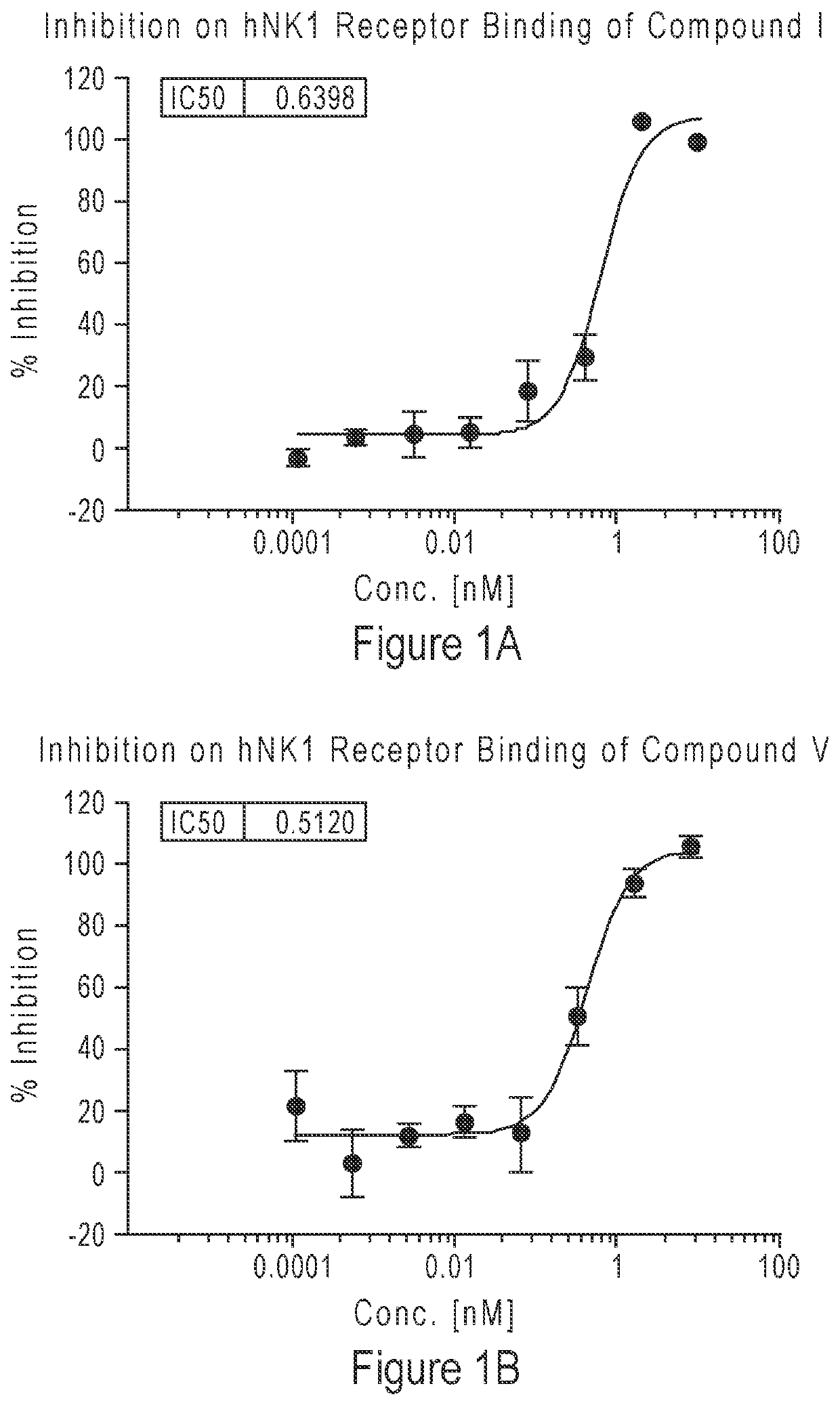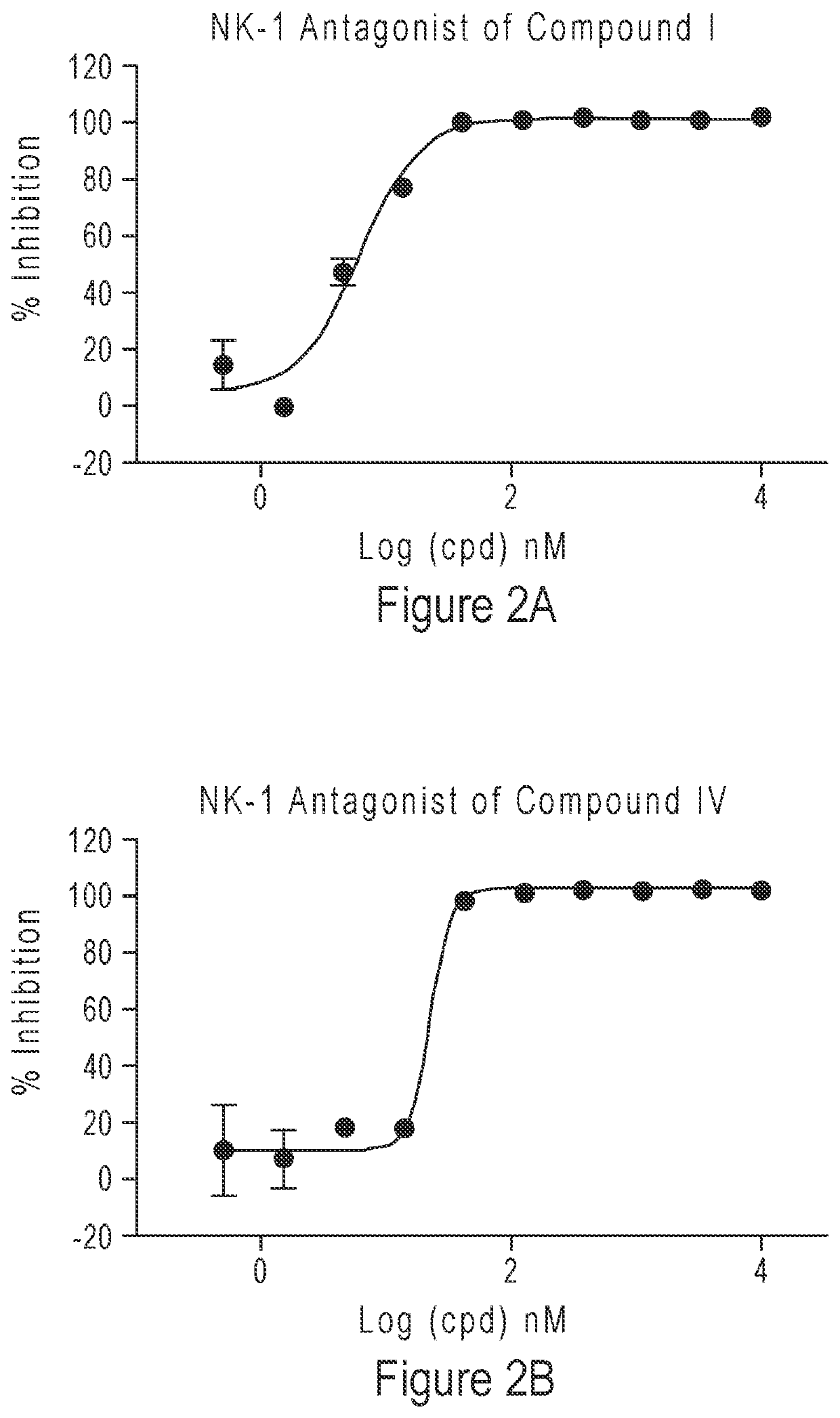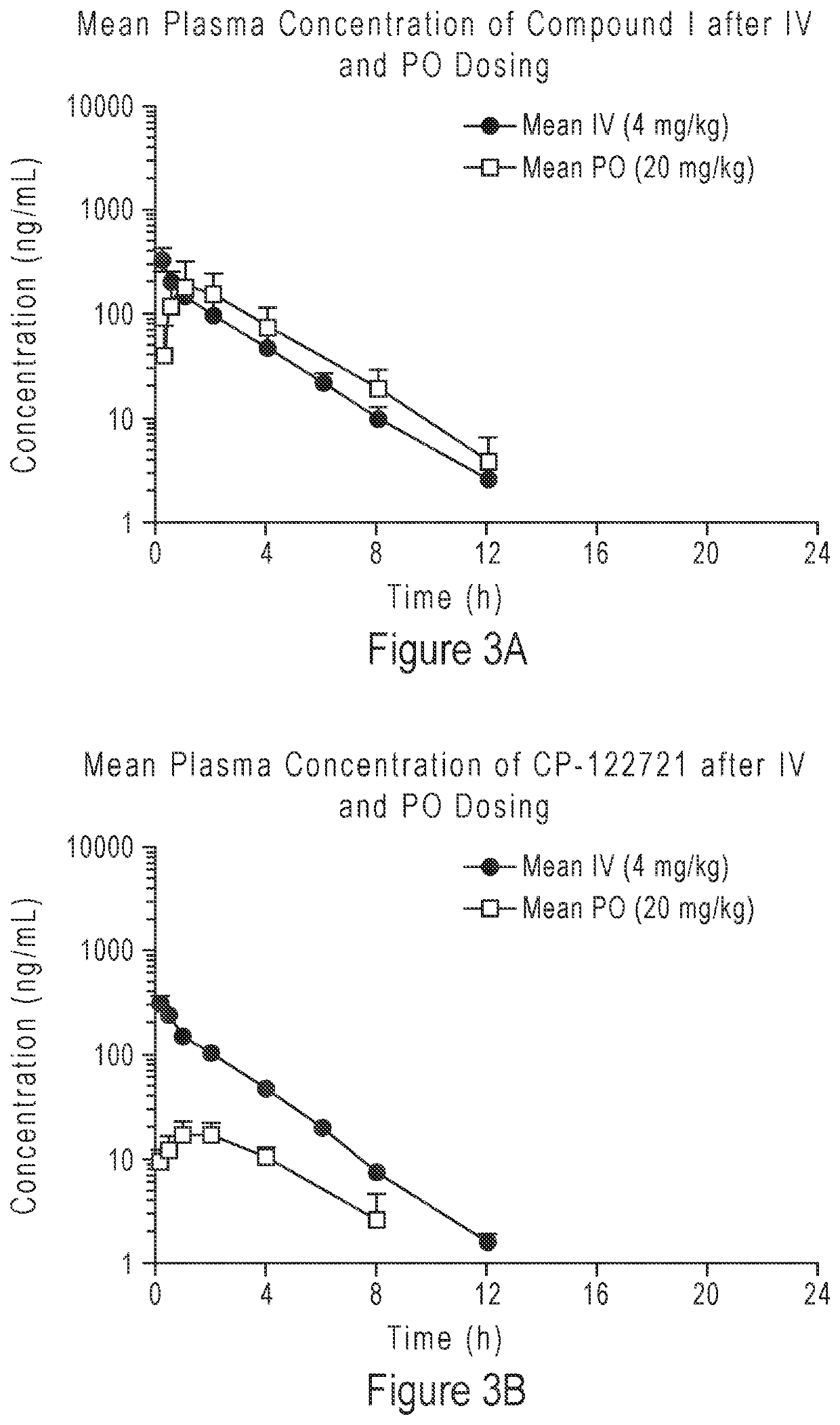Compounds as neurokinin-1 receptor antagonists and uses thereof
a technology of neurokinin-1 and compounds, applied in the field of medicinal technology, can solve the problems of poor prognosis of human glioblastoma, while rare, and achieve the effect of improving the prognosis and reducing the risk of glioblastoma
- Summary
- Abstract
- Description
- Claims
- Application Information
AI Technical Summary
Benefits of technology
Problems solved by technology
Method used
Image
Examples
example 1
(2S,3S)—N-(2-methoxy-5-(pentafluorosulfanyl)benzyl)-2-phenylpiperidin-3-amine (I)
[0275]
Step 1: 1-methoxy-4-(pentafluorosulfanyl)benzene (11)
[0276]To a stirred solution of 1-nitro-4-(pentafluorosulfanyl)benzene (10) (5.0 g, 20.1 mmol) in DMF (50 mL) at 25° C. was added MeONa (5.4 g, 100.5 mmol) in portions. The reaction was stirred at 25° C. for 0.5 h and then quenched with water (200 mL). The resulting mixture was extracted with EA (2×100 mL). The combined organic phase was washed with brine (2×100 mL), dried over anhydrous MgSO4, filtered and concentrated. The residue was purified by column chromatography (silica gel, PE) to afford the titled compound 11 (3.0 g, 64%) as a colorless oil. 1H NMR (400 MHz, CDCl3) δ=7.68 (d, J=9.2 Hz, 2H), 6.91 (d, J=8.8 Hz, 2H), 3.85 (s, 3H).
Step 2: 2-bromo-1-methoxy-4-(pentafluorosulfanyl)benzene (12)
[0277]To a stirred solution of 1-methoxy-4-(pentafluorosulfanyl)benzene (11) (3.0 g, 12.8 mmol) in HOAc (30 mL) was added Br2 (10.2 g, 64.1 mmol) at 25°...
example 2
(2S,3S)—N-(2-ethoxy-5-(pentafluorosulfanyl)benzyl)-2-phenylpiperidin-3-amine (II)
[0281]
Step 1: 2-nitro-4-(pentafluorosulfanyl)phenol (16)
[0282]To a stirred slurry of t-BuOK (4.2 g, 36.0 mmol) in MeNH2 (90 mL, 180 mmol, 2 M in THF) under N2 atmosphere was added a solution of 1-nitro-3-(pentafluorosulfanyl)benzene (15) (3.0 g, 12.0 mmol) and cumene hydroperoxide (2.4 g, 13.2 mmol) in dry THF (30 mL) dropwise at −78° C. The reaction was stirred at −50° C. for 0.5 h and then warmed to 25° C. The reaction mixture was quenched with aqueous HCl solution (6 M) until pH2SO4, filtered and concentrated. The residue was purified by column chromatography (silica gel, PE / EA=100% PE-100:1) to afford the titled compound 16 (3.0 g, 91%) as a yellow oil. 1H NMR (400 MHz, CDCl3) δ=10.79 (br. s., 1H), 8.57 (d, J=2.8 Hz, 1H), 7.96 (dd, J=2.6, 9.2 Hz, 1H), 7.31-7.26 (m, 1H).
Step 2: 1-ethoxy-2-nitro-4-(pentafluorosulfanyl)benzene (17)
[0283]To a stirred solution of 2-nitro-4-(pentafluorosulfanyl)phenol (16...
example 3
(2S,3S)—N-(2-isopropoxy-5-(pentafluorosulfanyl)benzyl)-2-phenylpiperidin-3-amine (III)
[0289]
Step 1: 1-isopropoxy-2-nitro-4-(pentafluorosulfanyl)benzene (22)
[0290]To a stirred solution of 2-nitro-4-(pentafluorosulfanyl)phenol (16) (0.5 g, 1.9 mmol) and 2-iodopropane (0.6 g, 3.8 mmol) in CH3CN (5 mL) in a sealed tube was added K2CO3 (0.6 g, 4.7 mmol). The reaction was heated under reflux in a sealed tube for 16 h, filtered and concentrated. The residue was purified by column chromatography (silica gel, PE / EA=100:0-50:1) to afford the titled compound 22 (0.2 g, 35%) as a yellow solid. 1H NMR (400 MHz, CDCl3) δ=8.21 (d, J=2.8 Hz, 1H), 7.87 (dd, J=2.4, 9.2 Hz, 1H), 7.12 (d, J=9.2 Hz, 1H), 4.84-4.71 (m, 1H), 1.44 (d, J=6.0 Hz, 6H).
Step 2: 2-isopropoxy-5-(pentafluorosulfanyl)aniline (23)
[0291]To a stirred solution of 1-isopropoxy-2-nitro-4-(pentafluorosulfanyl)benzene (22) (0.2 g, 0.65 mmol) in EtOH (2 mL) and concentrated HCl (0.5 mL) was added Fe powder (109 mg, 2.0 mmol) in portions at ...
PUM
 Login to View More
Login to View More Abstract
Description
Claims
Application Information
 Login to View More
Login to View More - R&D
- Intellectual Property
- Life Sciences
- Materials
- Tech Scout
- Unparalleled Data Quality
- Higher Quality Content
- 60% Fewer Hallucinations
Browse by: Latest US Patents, China's latest patents, Technical Efficacy Thesaurus, Application Domain, Technology Topic, Popular Technical Reports.
© 2025 PatSnap. All rights reserved.Legal|Privacy policy|Modern Slavery Act Transparency Statement|Sitemap|About US| Contact US: help@patsnap.com



